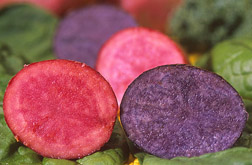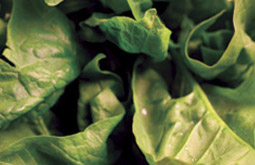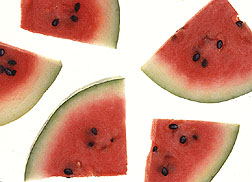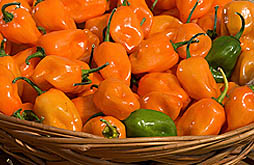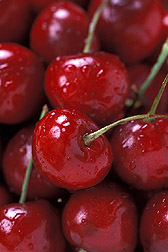| October 2007 |
Want Garlic's Goodness? Crush It!
|
|
Consuming large amounts of raw garlic may be good for your heart, but not necessarily your social life. So, how do we best enjoy these pungent little bulbs without missing out on their impressive health benefits? Crush them, then bake them slightly. That's according to Agricultural Research Service (ARS) scientists and collaborators in Argentina who found that lightly cooked, crushed garlic provides most of the health benefits found in raw garlic.
Details: /is/pr/2007/070918.htm
Scientific contact: Philipp W. Simon, (608) 262-1248; USDA-ARS Vegetable Crops Research Unit, Madison, Wis.
Potatoes: Chock Full of Intriguing Phytochemicals
|
|
Americans love their spuds, consuming 130 pounds per person annually. Now that culinary love affair could grow even more passionate with Agricultural Research Service (ARS) findings that some potato varieties are packed with health-promoting compounds called phytochemicals. Using a new analytical method, ARS plant geneticist Roy Navarre and colleagues in Washington State and Oregon have identified 60 different kinds of phytochemicals and vitamins in the skins and flesh of 100 wild and commercially grown potatoes.
Details: /is/pr/2007/070907.htm
Scientific contact: Roy Navarre, (509) 786-9261; USDA-ARS Vegetable and Forage Crops Research Unit, Prosser, Wash.
Blueberry Extracts Battle Brain Cell Inflammation
An abnormal immune system can mistake body tissue for a foreign invader and attack it, causing inflammation. Researchers are learning how similar dynamics occur in the brain. Agricultural Research Service (ARS) scientists have found that blueberry extracts helped quell the inflammation that was produced when the brain's immune cells responded to oxidative stress, based on a culture of animal cells.
Details: /is/pr/2007/070821.htm
Scientific contact: James A. Joseph, (617) 556-3178, ARS Jean Mayer USDA Human Nutrition Research Center on Aging, Boston, Mass.
Vitamin K May Help Quell Osteoarthritis
|
|
Could getting enough dietary vitamin K help keep osteoarthritis at bay? Study volunteers with the highest blood levels of the main form of vitamin K, called phylloquinone, were associated with the lowest risk, among participants, of having osteoarthritis in the hands and knees. The study was conducted by Agricultural Research Service (ARS)-funded scientists.
Details: /is/pr/2007/070801.htm
Scientific contact: Sarah L. Booth, (617) 556-3231, ARS Jean Mayer USDA Human Nutrition Research Center on Aging, Boston, Mass.
Pursuing the Perfect Sour Taste
|
|
Food manufacturers may soon have more control over the amount of sour taste that comes through in a variety of acidified food products. Sour is one of only five primary human taste sensations, and is stimulated by organic acids. In a study led by an Agricultural Research Service (ARS) scientist, volunteers were presented with test solutions containing eight different organic acids—either with one acid at a time, or as mixtures of the acids. Organic acids are molecules characterized by the presence of carboxyl groups, which is what makes them acidic. Surprisingly, molecules of all eight organic acids were perceived to be equal in sour taste, provided that at least one carboxyl group in a molecule had a hydrogen ion attached to it. When no hydrogen ion was attached, no sour taste was detected at all.
Details: /is/pr/2007/070705.htm
Scientific contact: Roger F. McFeeters, (919) 515-2990, USDA-ARS Food Science Research Unit, Raleigh, N.C.
Ready-to-Eat Meats and Poultry: Food Safety Simplified
|
|
A new Internet resource helps companies answer food safety questions and helps food processors make science-based food production decisions. The Predictive Microbiology Information Portal (PMIP), available at https://portal.errc.ars.usda.gov/, was developed by Agricultural Research Service (ARS) scientists at Wyndmoor, Pa., working with colleagues at USDA's Food Safety and Inspection Service, Rutgers University, and Decisionalysis Risk Consultants, Inc., in Canada. Currently, PMIP offers information on research, regulations and resources related to Listeria monocytogenes in ready-to-eat foods, the prototype identified for the project by FSIS. In the coming months, it will be expanded to include other pathogen and food combinations.
Details: /is/pr/2007/070919.htm
Scientific contact: Vijay K. Juneja, (215) 233-6500, USDA-ARS Eastern Regional Research Center, Wyndmoor, Pa.
Watermelons With Lower Sugar Move Closer to Market
|
|
Agricultural Research Service (ARS) plant geneticist Angela Davis in Lane, Okla., has bred three new lower-sugar melons that should be a welcome treat for dieters, diabetics and everyone else wishing to curb their sugar or carb intakes. Davis is sharing the new watermelon stock with interested growers. Like all watermelons, the new cultivars are an excellent source of lycopene, a powerful antioxidant associated with a lower incidence of some cancers. They're also rich in vitamin A and potassium.
Details: /is/pr/2007/070719.htm
Scientific contact: Angela R. Davis, (580) 889-7395, extension 263; USDA-ARS South Central Agricultural Research Laboratory, Lane, Oka.
TigerPaw-NR Habanero Blasts Taste Buds
The super-hot, bright orange TigerPaw-NR habanero pepper offers extreme pungency for pepper aficionados, plus nematode resistance that will make it a hit with growers and home gardeners. Agricultural Research Service (ARS) scientists Richard L. Fery and Judy A. Thies put the pepper through three years of greenhouse and field tests before determining, in 2006, that it was ready for commercial fields and backyard gardens. The firm, shiny pepper gets its name from its tiger-paw-like appearance. Its "NR" initials stand for "nematode resistant," a prized trait. The pepper is the first commercial habanero pepper resistant to attack by microscopic, soil-dwelling worms known as root-knot nematodes, according to the scientists.
Details: /is/pr/2007/070702.htm
Scientific contact: Richard L. Fery, (843) 402-5300, extension 530; USDA-ARS U.S. Vegetable Laboratory, Charleston, S.C.
|
|
New: GreenPack-DG and WhipperSnapper Southernpeas
Two new varieties of southernpeas—WhipperSnapper and GreenPack-DG—boast attractive colors, pleasing textures and flavors, plus nutrients like protein and folate, a B vitamin. Agricultural Research Service (ARS) scientist Richard L. Fery co-developed these superior southernpeas. Both southernpeas were offered to seed producers and researchers for the first time in 2006, after years of laboratory, greenhouse and field tests. GreenPack-DG is the only pink-eyed southernpea that has two genes for greenness, not just one. Its "DG" initials stand for "double green." WhipperSnapper can be picked when the pods are still immature, tender and edible, then sold as fresh snaps. The pods also can be left on the vine until ready to sell with full-sized peas either within the pods, or shelled.
Details: /is/pr/2007/070718.htm
Scientific contact: Richard L. Fery, (834) 402-5300, extension 530, USDA-ARS U.S. Vegetable Laboratory, Charleston, S.C.
Organic, All-Fruit Bars: Tasty Outcome of ARS Research
|
|
Flavorful, all-fruit snack bars, made from organically grown apples and berries, stay moist and chewy for up to 24 months, without the need for artificial preservatives. That's thanks to an innovative process developed by Agricultural Research Service (ARS) scientists in Albany, Calif. The organic bars are marketed under the Bear Fruit Bar brand by Mountain Organic Foods LLC of Hood River, Ore. The company holds a license from ARS to use the patented technology. ARS food technologist Tara H. McHugh worked with agricultural engineer Charles C. Huxsoll, now retired from ARS, to perfect a technique for processing fruits and vegetables into convenient, all-natural bars that can be enjoyed year-round, not just when these highly perishable foods are in season.
Details: /is/pr/2007/070917.htm
Scientific contact: Tara H. McHugh, (510) 559-5864, USDA-ARS Western Regional Research Center, Albany, Calif.



